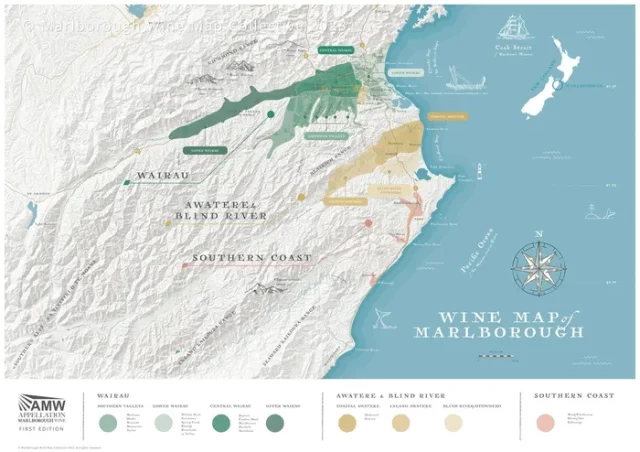This website uses cookies so that we can provide you with the best user experience possible. Cookie information is stored in your browser and performs functions such as recognising you when you return to our website and helping our team to understand which sections of the website you find most interesting and useful.
New Zealand’s Marlborough region launches first appellation map
Appellation Marlborough Wine (AMW) has launched an official wine map of Marlborough, delineating the region for the first time, to combat “the commoditisation of Marlborough Sauvignon Blanc” and highlight that not all of the region’s wines “taste the same”, AMW chair John Buchanan told the drinks business.

The AMW was established in 2018 to protect the integrity, authenticity and brand value of wines produced in Marlborough, New Zealand. The map is the latest project undertaken by the group, aiming to highlight the diversity and subregional detail of the Marlborough region.
“Everyone in the trade and all avid wine consumers recognise that over time, wine quality tends to zero in on smaller areas, and those smaller areas are singled out as such whether they be a subregion, a microregion, a single vineyard or even a certain parcel of a vineyard. To do this, you need a universally accepted map,” Buchanan explained, noting that the map’s creation could lead to more detailed subregional maps and sub-GI’s being officially recognised in the future.
“AMW recognises that Marlborough has a wealth of diversity, not just with other varieties but stylistic diversity between our Sauvignons too, depending on where they come from. The map is a key tool in helping us communicate that message, and to celebrate it.”
Buchanan hopes the project will lead to more consumers and trade professionals refer to subregions in reference to Marlborough wines, such as Blind River Sauvignon Blanc, Waihopai Sauvignon Blanc or Dillons Point Sauvignon Blanc.
Launched in early June, the map is a first edition, and the AMW plans to evolve its contents “as our relatively young region evolves”, Buchanan told db.
The aim of the project is fundamentally to communicate that “AMW stands against the “commoditisation of Marlborough Sauvignon Blanc”, the group’s chair said. “It says not all Marlborough wine tastes the same, and these subregions and microregions are stylistically distinct because of their climatic and geological differences,” he added.
“Much like other great appellations of the world, value in products is driven by having a defined area – an identity – as well as quality parameters, which ensure that the consumer is getting what they expect and deserve in their glass. We are saying that after nearly 50 years of Sauvignon Blanc production in Marlborough, the world is ready for this greater level of detail in the Marlborough story, because there’s so much more to it than that,” he added.
Development of the map was led by “the realisation we were lacking this key reference tool to be able to tell the more nuanced Marlborough story”, he said.
The AMW has drawn on a European approach to appellations in developing the map, but says it is “acutely aware” of the “pitfalls” of the European model. “Appellation Marlborough Wine was created because of the same concerns that engendered these original European appellations: the need to protect the reputation of a regional brand (and the consumer) because of real or perceived risk of fraudulent activity,” Buchanan explained. However, he noted that due to the region’s youth, a “clean slate” provided an opportunity to “create a robust appellation model that is simple but is a vehicle to secure authenticity, build value and guard against fraud”.
AMW certified wines must be 100% Marlborough fruit and must be bottled in New Zealand. The wines must pass an independent blind tasting assessment every vintage, and vineyards and winery must be registered with the Sustainable Winegrowing New Zealand programme. Further measures are likely to be introduced in the future to strengthen the appellation’s quality assurances, Buchanan said.

